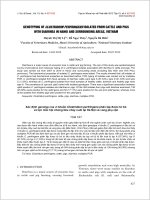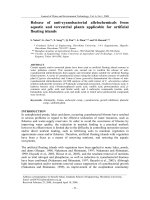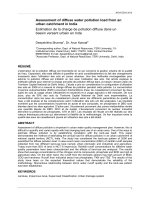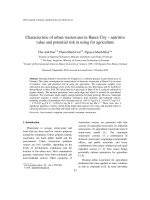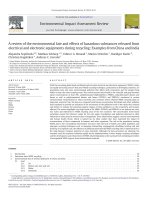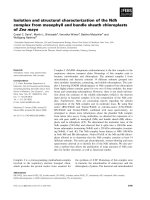Comparison of aerosol products retrieved from Aeronet and MODIS over an urban area in Hanoi city, Vietnam
Bạn đang xem bản rút gọn của tài liệu. Xem và tải ngay bản đầy đủ của tài liệu tại đây (554.39 KB, 10 trang )
Journal of Science and Technology in Civil Engineering NUCE 2018. 12 (5): 99–108
COMPARISON OF AEROSOL PRODUCTS RETRIEVED
FROM AERONET AND MODIS OVER AN URBAN AREA
IN HANOI CITY, VIETNAM
Bui Thi Hieua , Nguyen Duc Luonga,∗, Nguyen Hoang Hiepa , Bui Quang Trunga
a
Faculty of Environmental Engineering, National University of Civil Engineering,
55 Giai Phong road, Hai Ba Trung district, Hanoi, Vietnam
Article history:
Received 04 June 2018, Revised 18 July 2018, Accepted 30 July 2018
Abstract
To understand the dynamics of aerosols and their associated influence on regional and global climatic conditions requires the knowledge of spatial and temporal distributions of aerosols on regional and global scales.
In this study, the satellite-based MODIS AODs retrievals level 2 products from Terra (MOD04-10 km) and
Aqua (MYD04-10 km) satellites were inter-compared with the ground-based AERONET AODs (level 2) over
Nghia Do station located in an urban area of Hanoi city, Vietnam for the period of 2010–2016. The Terra AODs
showed good-match with the ground-based AODs measurements (slope = 0.830, intercept = 0.099, RMSE =
0.260, R2 = 0.673, and RMB = 0.970). However, the Aqua AODs expressed systematically the underestimation
of AERONET AODs (slope = 0.556, intercept = 0.184, RMSE = 0.390, R2 = 0.408, and RMB = 0.810). All
MODIS AODs indicated the moderate correlation with AERONET AODs (slope = 0.683, intercept = 0.147,
RMSE = 0.330, R2 = 0.520, and RMB = 0.890). Although MODIS AODs followed well the monthly variations of AERONET AODs, the relatively high discrepancy between MODIS and AERONET AODs could be
observed during the winter months.
Keywords: aerosol products; MODIS AODs; AERONET AODs; inter-comparison.
/>
c 2018 National University of Civil Engineering
1. Introduction
The knowledge of spatial-temporal distributions of aerosols is vitally important for both air quality
and climate applications. Due to sparse sampling by ground-based measurements, satellite remote
sensing techniques play an important role to provide systematic retrieval of aerosol optical properties
on regional and global scales. Satellite observations could provide information over the larger spatial
domain while the ground-based measurements just could provide information over a particular limited
region. However, in order to confirm the usefulness of satellite-based aerosol optical depth (AOD) for
air quality and climate application, it is important to characterize the performance of satellite-based
AOD product for daily basis as well as seasonal and annual AOD cycles by comparing the satellite
product to ground-truth observations.
The MODerate Resolution Imaging Spectroradiameters (MODIS) aboard Terra and Aqua satellites observe the earth-atmosphere system twice daily, provide AOD estimations for both land and
ocean. Comparison and evaluation of MODIS AOD products with the ground-based AOD measurements obtained from collocated ground-based sunphotometers NASA’s Aerosol Robotic NETwork
∗
Corresponding author. E-mail address: (Luong, N. D.)
99
Hieu, B. T. et al. / Journal of Science and Technology in Civil Engineering
(AERONET) have been studied globally and locally [1–11]. However, according to our intensive
literature review, there have been few studies conducted in Vietnam relating to MODIS AOD satellite data so far. To our knowledge, there are only two researches that compare MODIS AOD and
ground-based AERONET AOD measurements [12]. However, these researches used MODIS AOD
Collection 5 product. Recently, the latest MODIS AOD Collection 6.1 has been released with modified algorithm for aerosol retrieval over land surface. Therefore, in present study, the fine spatial
resolution (10 km × 10 km) MODIS AOD products in the latest collection 6.1 MOD04 and MYD04
are inter-compared with AERONET AOD to characterize the deviations between satellite-retrievals
and ground-based measurements for the first time over the urban area in Hanoi city by two means: (1)
the correlation and level of agreement between collocated AERONET AOD measured during MODIS
overpass hours with the MODIS AOD; and (2) the ability of monthly-averaged MODIS AOD to track
AERONET AOD.
2. Data and methods
2.1. MODIS dark target 10 km level 2 products
MODIS data includes different processing levels: (1) level 1.0 is geolocated and calibrated brightness temperature and radiances); (2) level 2.0 is derived geophysical data products; and (3) level 3.0
is gridded time-averaged products. This study employed the latest MODIS AOD level 2 product collection 6.1 MOD04 and MYD04 instantaneous AODs at the wavelength of 550 nm using Dark target
(DT) algorithm.
The “Level 2” MODIS high-resolution aerosol product is geophysical derived at 10 km spatial resolution (at nadir), and known as MOD04_10 km (for Terra) and MYD04_10 km (for Aqua).
Collectively, referred to as MxD04, the data used here (from Jan 2010 to December 2016 which corresponding to the period that the AERONET AOD data is available for our study area) are products
from consistent application of the DT retrieval algorithm [13, 14], instrument calibration, and computer processing environment. Although the data are from Collection 6.1, the MODIS DT retrievals
of aerosols use two separate algorithms for land and ocean. The goal of the DT land algorithm is
to use the lookup table to determine the conditions that best mimic the MODIS-observed spectral reflectance by interpreting the contrast of aerosol (relatively high) against the dark surface back ground.
For the 10 km (nominal at nadir) retrieval, MODIS measured reflectance are organized into nominal
10 km - 10 km retrieval boxes which include 20 × 20 0.5 km pixels. 400 pixels in the box are pixel-bypixel masked to remove the undesirable pixels including clouds, snow/ice, and other bright surfaces.
These 400 pixels are separated to land and water pixels. 20% of the darkest remaining pixels and 50%
of the brightest remaining pixels are discarded using 0.66 micrometer channel for brightness check.
The DT 10 km retrievals algorithm required at least 51 pixels over land for performing best quality
aerosol retrieval.
A “dark-target” retrieval algorithm over land retrieving aerosol properties uses three spectral channels centered at 0.47, 0.66, and 2.13 micrometer wavelength which are mainly influenced by surface
reflectance and aerosol type. With the assumption that the 2.13 micrometer wavelength contains the
information about surface reflectance as well as coarse-mode aerosol, the DT algorithm attempts to retrieve when the observed reflectance at 2113 nm is between 0.01 and 0.25. For the surface properties,
the algorithm makes a major assumption (primarily for vegetated surfaces) that the surface reflectance
in the visible wavelength (0.47 and 0.65 micrometer) are the function of a shortwave-infrared (SWIR)
MODIS channel (2113 nm), Normalized Differential Vegetation Index (NDVI, Karnieli et al., 2001)
100
Hieu, B. T. et al. / Journal of Science and Technology in Civil Engineering
calculated using MODIS SWIR channels centered at 1243 nm and 2113 nm [13] and scattering angle.
Collection 6.1 have added an urban surface parametrization as a branch of retrieval algorithm. The
urban retrieval is performed whenever 20% of the pixels in a retrieval box are identified as urban.
Aerosol model type and a model spectral surface reflectance appropriate for the regional vegetation indices and season are prescribed to present Look Up Table (LUT). The DT algorithm compares
the observed MODIS spectral reflectance with spectral reflectance from LUT to find the best match.
From the lookup table, the atmospheric path reflectance (ρa), atmospheric transmission (T), normalized downward flux (F), and atmospheric backscattering ratio (s) (for the fine model and coarse
model separately) are interpolated for angle, resulting in six values for each parameter, corresponding
to aerosol loading (indexed by τ at 0.55 µm). For discrete values of η between −0.1 and 1.1 (intervals
of 0.1), the algorithm attempts to find the τ at 0.55 µm and the surface reflectance at 2.12 µm that
exactly matches the MODIS measured reflectance at 0.47 µm. There will be some error, ε, at 0.65
µm. The solution is the one where the error at 0.65 µm is minimized. The primary products are τ
(τ0.55), η (η0.55), and the surface reflectance (ρs2.12). The error ε is also noted.
2.2. AERONET AODs product
The AERONET (Aerosol Robotic NETwork) is ground-based remote sensing aerosol networks
which employs CIMEL sun-sky spectral radiometer to measure the direct solar radiance at nine wavelength and the sky radiance at four wavelengths using standard AERONET protocols [1]. AOD at each
of the nine wavelengths (except 940 nm) are calculated using the direct solar radiance measurements
based on Beer-Lambert-Bouguer law. The AERONET AOD retrieval corrects optical depth for attenuation due to Rayleigh scattering, absorption by ozone and gaseous pollutants. Most sun-photometers
make a measurement every 15 minutes during the day at several wavelengths, from which AOD values are derived with a precision of the order of 0.01 to 0.02 [1]. AERONET data is available at three
levels: Level 1.0 (unscreened), Level 1.5 (cloud screened), and Level 2.0 (cloud screened and quality
assured). In this study, we used the Level 2.0 AERONET data. In our study, we used the data for the
period of 2010–2016 obtained from Nghia Do station - an AERONET measurement site in Ha Noi
(21.04◦ N, 105.79◦ E) which operated since 2010. The data was downloaded from the AERONET
website ( />2.3. Method for comparison between MODIS satellite-based and AERONET ground-based AODs
The ground-based AERONET AOD and satellite-based MODIS AOD data are obtained from
different sources which have different temporal and spatial resolutions. For performing the correlation
analysis between these two datasets, it is necessary to pre-process these datasets to be consistent in
space and time. Hence, collocating the air mass seen by MODIS sensor from the space over the
study area with the one measured by AERONET from the ground simultaneously is required. First,
only AERONET AOD ground-based measurements and MODIS AOD satellite measurements taken
on the same day was considered for pairing. For each day, the distance was calculated between the
latitude and longitude of each of the satellite measurements made on that day and each of the groundbased data. Next, for ground-based station on each day, the closest satellite measurement for that day
was found. This separation requirement is consistent with a lagged correlation analysis conducted on
the surface measurements by Anderson et al. [15]. Once AERONET station was paired with satellite
measurements spatially, time was taken into account. In this study, we averaged the MODIS AOD
values at the 10 km × 10 km spatial resolution over the 50 km × 50 km grid box centered at AERONET
station [3].
101
Hieu, B. T. et al. / Journal of Science and Technology in Civil Engineering
Because the AOD values can vary substantially during the course of a single day, the MODIS
AOD data can be compared with the reference AERONET data collected only at comparable times of
the day. The time matching of the AERONET AOD data with the MODIS AOD retrievals was made
following the method of Ichoku et al. [16]. In particular, the AERONET data was averaged within
±30 min of the satellite’s passing. After this averaging, AERONET AOD measurements at 0.50 µm
˚
were interpolated to a common wavelength of 0.55 µm using the values of the Angstr¨
om exponents
also available in the AERONET data set as the following equation:
AODa = AODb
a
b
−α
(1)
˚
where a = 0.55 µm for MODIS, b = 0.50 µm for AERONET, and α is the (0.44-0.87 µm) Angstr¨
om
exponent [17].
Thus, over 7 year period (from 2010 to 2016), we obtained 105,107 collocated data set for MODIS
(Terra)-AERONET and MODIS (Aqua)-AERONET, respectively.
This interpolation is necessary for allowing direct comparison of the AERONET data with the
MODIS retrievals at the same wavelength. For satellite data, MODIS AOD was averaged over a square
has the side of 40 km with a sunphotometer in its center. The mean values of the collocated spatial
and temporal ensemble were then used in validation. Here linear regression analysis was performed
for MODIS AOD with respect to AERONET AOD using the following equation:
AODMODIS = m × AODAERONET + c
(2)
where AODMODIS and AODAERONET represent the AODs from MODIS and AERONET, respectively;
m is the slope; and c is the vertical intercept. The regression coefficient (R2 ), which is the square of the
correlation coefficient, indicates the correlation between MODIS and AERONET AODs. All of these
quantities (m, c, and R2 ) serve as useful indicators of the local spatial characteristics of the aerosol
parameter (AOD) at a particular location and time [3]. The slope (m) of the linear regression equation
reveals how close the assumed aerosol model over a particular region is to the local aerosol type,
and the intercept (c) indicates the error caused by surface reflectance [5–11]. The linear regression
equation therefore provides information concerning the factors that affect the correlation. If there is a
perfect correlation between AODMODIS and AODAERONET then the value of c would be 0, the values of
R2 and m would be 1 [5]. Large intercepts are due to large errors in surface reflectance and at ground
surface reflection the retrieval algorithm is biased towards low AOD values, which are indicated by
non-zero intercepts that may be associated with an inappropriate assumption or with calibration error
[3, 5]. In contrast to real situations, where the slope in the retrieval algorithm is other than unity
this may indicate some irregularities between the optical properties and the aerosol microphysical
properties used in the retrieval algorithm.
In addition to using linear regression, we also computed the root mean square error (RMSE)
between the MODIS and AERONET AOD observations. The RMSE is defined as:
RMSE =
1
n
n
(AOD(MODIS)i − AOD(AERONET)i )2
(3)
i=1
where n is the number of observations.
Overestimation or underestimation of retrievals can be quantified by calculating the root mean
bias (RMB), which is defined as:
AODMODIS
RMB =
(4)
AODAERONET
102
Hieu, B. T. et al. / Journal of Science and Technology in Civil Engineering
If RMB < 1, then this represents an underestimation, and if RMB > 1, this represents an overestimation.
3. Results
Fig. 1 expresses the relationship between the Terra AOD and Aqua AOD retrievals against
AERONET derived AODs from 2010 to 2016. In Fig. 1, the black and red colored lines represent
1-1 line, the linear regression of the scatter plot. It is seen that the coefficient of determination R2
values are 0.673 and 0.408 for Terra AOD and Aqua AOD, respectively. The MODIS/AERONET
regression slopes and intercepts for Terra are significantly better than those for Aqua. The slopes of
regression lines are 0.830 and 0.556 for Terra and Aqua, respectively; and the intercepts for Terra and
Terra
and respectively.
Aqua, respectively; and the intercepts for Terra and Aqua are 0.184
Aqua are 0.556
0.184for
and
0.099,
and 0.099, respectively.
Fig. 1. Correlation plots of MODIS (Terra and Aqua) AOD retrievals against AERONET
Figure 1. AODs
Correlation
MODIS
(Terra
and Aqua)
AOD retrievals
against AERONET
AODs from 2010
from plots
2010 of
to 2016.
(The
red solid
lines indicate
linear regression
and the dotted
to 2016.
(The
redrepresent
solid lines
black
lines
1:1indicate
lines). linear regression and the dotted black lines represent 1:1 lines)
In addition, it can be seen from Table 1 that the RMSE values between the ground-
In addition,
it can be seen
TableAODs
1 that the
values
between
the ground-based
AERONET
based AERONET
andfrom
MODIS
are RMSE
0.260 and
0.390
for Terra
and Aqua,
respectively.
The
RMB
value
of
Aqua
retrieval
AODs
(0.810)
indicates
the
systematical
and MODIS AODs are 0.260 and 0.390 for Terra and Aqua, respectively. The RMB value of Aqua
underestimation of the ground-based AERONET AOD measurements. However, Terra
retrieval AODs
(0.810)
indicates
thethe
systematical
underestimation
of the
ground-based
AODs shows
good
match with
AERONET AODs
with RMB value
of 0.970
which is AERONET
close
to
unity.
In
addition,
the
correlation
plots
of
all
MODIS
AODs
retrievals
against
the with RMB
AOD measurements. However, Terra AODs shows good match with the AERONET AODs
measured AODs are shown in Fig. 1c. As the effect of combination of both Terra and
value of 0.970
which the
is close
to unity.
In addition,
all MODIS
retrievals
Aqua AODs,
R2, slope,
intercepts,
RMSE the
and correlation
RMB valuesplots
of allof
MODIS
AODs AODs
are
better
than those
for are
the shown
case with
only 1c.
Aqua
considered
(0.520, 0.683,
0.147,
against the
measured
AODs
in Fig.
AsAODs
the effect
of combination
of both
Terra and Aqua
0.330,
and 0.890, respectively). Levy et al. [8] found no significant difference between
AODs, the
R2 , slope,
intercepts, RMSE and RMB values of all MODIS AODs are better than those for
AERONET/Terra agreement and AERONET/Aqua agreement in their global Collection
the case with
only
Aqua AODs
considered
0.683,
0.147,
0.330,higher
and 0.890,
Levy
5 (C5)
validation
study. However,
they(0.520,
reported
that Terra
measured
(lower)respectively).
AOD
than
AERONET
over
land
up
until
(after)
2004.
The
Terra
AOD
drift
was
attributed
to
et al. [8] found no significant difference between AERONET/Terra agreement and AERONET/Aqua
radiance calibration drift, especially in the blue channel. This drift has been reduced for
agreement in their global Collection 5 (C5) validation study. However, they reported that Terra measured higher (lower) AOD than AERONET over land up until (after) 2004. The Terra AOD drift was
attributed to radiance calibration drift, especially in the blue channel. This drift has been reduced for
MODIS C6 and C6.1, but the low bias for Terra 6AOD over land is expected to persist [18].
103
Hieu, B. T. et al. / Journal of Science and Technology in Civil Engineering
Table 1. Result of regression analysis for MODIS (Terra and Aqua) derived AOD against AERONET
measurements at 550 nm from 2010–2016
Year
n
Slope
Intercept
R2
RMSE
RMB
Terra
Aqua
Terra & Aqua
105
107
212
0.830
0.556
0.683
0.099
0.184
0.147
0.673
0.408
0.520
0.260
0.390
0.330
0.970
0.810
0.890
At Nghia Do station, there are totally 212 collocated MODIS-AERONET data pairs. It can be
seen from Table 2 that the number of collocated MODIS-AERONET data depends on seasons and
local weather condition in Hanoi. During the early winter months (October, November, and December), local weather are featured with clear-sky and low relative humidity. This dry weather condition
is great advantage for satellite to observe the Earth as well as measure the solar radiation from the
ground. Therefore, the number of collocated MODIS-AERONET data pairs in those months are relatively larger than those in the other months in winter. In addition, during the late winter months
(January, February, and March), the drizzly weather is featured with cloudy and foggy sky. Therefore,
the MODIS-AERONET data pairs are relatively smaller than those in the early winter months. During
the monsoon months which characterized by hot and humid weather with abundant rainfall, the thick
cloud from summer abundant rainfall is the cause of significantly low AODs data pairs in June, July,
August, and September (10, 7, 15, and 3 data pairs, respectively).
Table 2. Statistical summary of monthly averaged AODs for MODIS and AERONET
at Nghia Do station from 2010 to 2016
Month
JAN
FEB
MAR
APR
MAY
JUN
JUL
AUG
SEP
OCT
NOV
DEC
STD(∗ )
Number Mean
of
of
of
MODIS MODIS
data
AODs
pairs AODs
14
20
7
20
34
10
7
15
3
28
26
28
0.600
0.525
0.867
0.881
0.550
0.973
0.509
0.621
0.708
0.854
0.514
0.438
0.295
0.226
0.462
0.535
0.324
0.772
0.520
0.278
0.238
0.394
0.391
0.287
Mean of
AERONET
AOD
STD of
AERONET
AODs
Mean of
MODISAERONET
AOD
STD of
MODISAERONET
AODs
0.830
0.677
1.214
0.940
0.525
0.975
0.370
0.673
0.636
0.883
0.618
0.621
0.332
0.264
0.426
0.694
0.300
0.881
0.308
0.319
0.277
0.342
0.338
0.334
−0.230
−0.152
−0.347
−0.059
0.025
−0.002
0.138
−0.052
0.072
−0.029
−0.105
−0.183
0.342
0.344
0.340
0.340
0.329
0.340
0.295
0.290
0.282
0.279
0.253
0.259
(∗ ): STD = Standard deviation
The monthly-averaged AOD using all MODIS and AERONET measurements (independent of
collocation) are calculated to assess MODIS ability to track monthly-averaged AERONET AOD
over the 7 years study period (Fig. 2). In Fig. 2, the monthly-averaged MODIS AODs, AERONET
104
Hieu, B. T. et al. / Journal of Science and Technology in Civil Engineering
AODs, and the discrepancy between satellite-based and ground-based AODs are illustrated using
dash blue line, red solid line, and dash green line, respectively. AODs measurements form MODIS
and AERONET range from 0.438 to 0.973 and from 0.370 to 1.214, respectively with standard deviation values range from 0.226 to 0.772 and 0.264 to 0.881, respectively. Fig. 2 shows the peaks of
MODIS and AERONET AOD retrieval values occuring at the beginning of winter (October) and at
the end of winter (March) with moderate standard deviation values (from 0.338 to 0.462). In addition,
the measured AODs of both MODIS and AERONET in June are another high peak (0.973 and 0.975)
with large standard deviation values (0.772 and 0.881). Pham et al. [12] also reported similar findings
that AOD load at Nghia Do station were high during the beginning of winter months (October and
November), and during the late winter months (March and April). Tran et al. [19] also found that AOD
load in Hanoi were high in October and March because of monsoon circulation affection and biomass
burning. Dust lifting and suspending in the air is result of North-East monsoon flows in October causing the stable temperature and dry weather in Hanoi. In addition, Huang et al. [20] and Le et al. [21]
reported the peak of biomass burning in Southeast Asia and in Vietnam in March.
Figure 2. Monthly AODs for MODIS and AERONET at Nghia Do station from 2010 to 2016 with error bars
indicating standard deviation values
It can be seen from Fig. 2 that MODIS AODs are able to capture the seasonal variations with the
AERONET AODs. Additionally, MODIS AODs shows good-match with the measurements AERONET
AODs for May and Jun with the small difference between MODIS and AERONET AOD (0.025 and
−0.002, respectively). In general, MODIS AODs retrievals underestimate the ground-based AOD
measurements for the remaining months of the year except for July and September. The discrepancy values of MODIS and AERONET AODs ranges from −0.002 to −0.347 with the standard
deviation values range from 0.253 to 0.344. The difference between satellite-based and groundbased AODs observations is generally high during winter with MODIS-AERONET AODs values of
−0.347, −0.230, −0.183, −0.105, and −0.152 in March, January, December, November, and February,
respectively. More et al. [22] compared the aerosol products retrieved from AERONET and MODIS
over a tropical urban area in India and found similar findings that “average monthly variation of
MODIS and AERONET AODs show similar pattern of variation with MODIS AOD values systematically less than those of AERONET AODs during winter”. The relative weak reflected signals from
105
Hieu, B. T. et al. / Journal of Science and Technology in Civil Engineering
the atmosphere (which is easily distracted by the high surface reflectance) are ultilized to obtain
aerosol properties. In addition, contributions of clouds and high concentrations of particulate matters
would be a factor leading to the improper assumption of surface reflectance and selection of aerosol
type over polluted area because the high loading of particulate matters prevents the transferring of
radiation from land to the satellite. Therefore, the high concentrations of particulate matters in the
atmosphere in dry and cool weather with little rainfall in winter [23] would the possibly contribute to
these discrepancies.
4. Conclusions
This paper made the inter-comparison between the MODIS AODs retrievals level 2 products
from Terra (MOD04-10 km) and Aqua (MYD04-10 km) onboard satellites and the ground-based
AERONET AODs obtained from Nghia Do station, Hanoi, Vietnam. The inter-compared results suggest that Terra AODs shows good-match with the ground-based AODs measurements (slope = 0.830,
intercept = 0.099, RMSE = 0.260, R2 = 0.673, and RMB = 0.970). However, Aqua AODs retrieval
expressed systematically the underestimation of AERONET AODs (slope = 0.556, intercept = 0.184,
RMSE = 0.390, R2 = 0.408, and RMB = 0.810). As the effect of Terra-Aqua AODs combination,
all MODIS AODs indicate the moderate correlation with AERONET AODs (slope = 0.683, intercept
= 0.147, RMSE = 0.330, R2 = 0.520, and RMB = 0.890). Although MODIS AODs were able to
capture the monthly variations of AODs load, the relatively high discrepancy between MODIS and
AERONET AODs was observed during the winter months. It is suggested that in future research,
AODs measurements from Terra and Aqua MODIS retrievals would be useful to characterize AODs
spatial and temporal distributions with further investigation about the systematic errors in MODIS
product during winter time.
Acknowledgements
The authors would like to thank the Korea Institute of Science and Technology (KIST), Korea
for providing the financial support for this research. The Level 2 MODIS data were provided by
Atmosphere Archive and Distribution System (LAADS) at Goddard Space Flight Center (GSFC),
( The authors would like to thank the AERONET
federation, AERONET scientific team and Principal Investigator Dr. N. X. Anh at Institute of Geophysics, Vietnam for the AERONET data for Nghia Do station.
References
[1] Holben, B. N., Eck, T. F., Slutsker, I. D., Tanré, D., Buis, J. P., Setzer, A., Vermote, E., Reagan, J. A.,
Kaufman, Y. J., Nakajima, T., Lavenu, F., Jankowiak, I., Smirnov, A. (1998). AERONET–A federated
instrument network and data archive for aerosol characterization. Remote Sensing of Environment, 66(1):
1–16.
[2] Chu, D. A., Kaufman, Y. J., Ichoku, C., Remer, L. A., Tanré, D., Holben, B. N. (2002). Validation
of MODIS aerosol optical depth retrieval over land. Geophysical Research Letters, 29(12):MOD2–1–
MOD2–4.
[3] Ichoku, C., Chu, D. A., Mattoo, S., Kaufman, Y. J., Remer, L. A., Tanré, D., Slutsker, I., Holben, B. N.
(2002). A spatio-temporal approach for global validation and analysis of MODIS aerosol products. Geophysical Research Letters, 29(12):MOD1–1–MOD1–4.
106
Hieu, B. T. et al. / Journal of Science and Technology in Civil Engineering
[4] Remer, L. A., Kaufman, Y. J., Tanré, D., Mattoo, S., Chu, D. A., Martins, J. V., Li, R. R., Ichoku, C.,
Levy, R., Kleidman, R. G., Eck, T. F., Vermote, E., Holben, B. N. (2005). The MODIS aerosol algorithm,
products, and validation. Journal of the Atmospheric Sciences, 62(4):947–973.
[5] Tripathi, S. N., Dey, S., Chandel, A., Srivastava, S., Singh, R. P., Holben, B. N. (2005). Comparison of
MODIS and AERONET derived aerosol optical depth over the Ganga Basin, India. Annales Geophysicae,
23(4):1093–1101.
[6] Misra, A., Jayaraman, A., Ganguly, D. (2008). Validation of MODIS derived aerosol optical depth over
Western India. Journal of Geophysical Research: Atmospheres, 113:D04203.
[7] Aloysius, M., Mohan, M., Babu, S. S., Parameswaran, K., Moorthy, K. K. (2009). Validation of MODIS
derived aerosol optical depth and an investigation on aerosol transport over the South East Arabian Sea
during ARMEX-II. Annales Geophysicae, 27(6):2285–2296.
[8] Levy, R. C., Remer, L. A., Kleidman, R. G., Mattoo, S., Ichoku, C., Kahn, R., Eck, T. F. (2010). Global
evaluation of the Collection 5 MODIS dark-target aerosol products over land. Atmospheric Chemistry
and Physics, 10(21):10399–10420.
[9] Retalis, A., Hadjimitsis, D. G., Michaelides, S., Tymvios, F. S., Chrysoulakis, N., Themistocleous, K.
(2010). Comparison of aerosol optical thickness with in situ visibility data over Cyprus. Natural Hazards
and Earth System Sciences, 10:421–428.
[10] Yang, J. M., Qiu, J. H., Zhao, Y. L. (2010). Validation of aerosol optical depth from Terra and Aqua
MODIS retrievals over a tropical coastal site in China. Atmospheric and Oceanic Science Letters, 3(1):
36–39.
[11] Hyer, E. J., Reid, J. S., Zhang, J. (2011). An over-land aerosol optical depth data set for data assimilation
by filtering, correction, and aggregation of MODIS Collection 5 optical depth retrievals. Atmospheric
Measurement Techniques, 4(3):379–408.
[12] Thanh, P. X., Anh, N. X., Le Khuong, P., Son, H. H., Son, N. X., Tuan, A. D. (2015). Characteristics of
aerosol optical depth retrieved from AERONET in Vietnam and comparison with MODIS data. Vietnam
Journal of Earth Sciences, 37(3):252–263.
[13] Levy, R. C., Remer, L. A., Dubovik, O. (2007). Global aerosol optical properties and application to moderate resolution imaging spectroradiometer aerosol retrieval over land. Journal of Geophysical Research:
Atmospheres, 112:D13210.
[14] Levy, R. C., Remer, L. A., Mattoo, S., Vermote, E. F., Kaufman, Y. J. (2007). Second-generation operational algorithm: Retrieval of aerosol properties over land from inversion of moderate resolution imaging
spectroradiometer spectral reflectance. Journal of Geophysical Research: Atmospheres, 112:D13211.
[15] Anderson, H. R., Butland, B. K., van Donkelaar, A., Brauer, M., Strachan, D. P., Clayton, T., van Dingenen, R., Amann, M., Brunekreef, B., Cohen, A. (2012). Satellite-based estimates of ambient air pollution and global variations in childhood asthma prevalence. Environmental Health Perspectives, 120(9):
1333–1339.
[16] Ichoku, C., Remer, L. A., Kaufman, Y. J., Levy, R., Chu, D. A., Tanré, D., Holben, B. N. (2003). MODIS
observation of aerosols and estimation of aerosol radiative forcing over southern Africa during SAFARI
2000. Journal of Geophysical Research: Atmospheres, 108(D13):8499.
[17] Liu, J., Zheng, Y., Li, Z., Wu, R. (2008). Ground-based remote sensing of aerosol optical properties in
one city in Northwest China. Atmospheric Research, 89(1-2):194–205.
[18] Levy, R. C., Mattoo, S., Munchak, L. A., Remer, L. A., Sayer, A. M., Patadia, F., Hsu, N. C. (2013). The
collection 6 MODIS aerosol products over land and ocean. Atmospheric Measurement Techniques, 6(11):
2989–3034.
[19] Tran, V. T., Pham, H. V., Nguyen, T. T. N., Pham, T. X., Bui, Q. H., Nguyen, A. X., Nguyen, T. T. (2018).
Satellite aerosol optical depth over Vietnam - An analysis from VIIRS and CALIOP aerosol products. In
Land-Atmospheric Research Applications in South and Southeast Asia, Springer, 499–522.
[20] Huang, K., Fu, J. S., Hsu, N. C., Gao, Y., Dong, X., Tsay, S. C., Lam, Y. F. (2013). Impact assessment of
biomass burning on air quality in Southeast and East Asia during BASE-ASIA. Atmospheric Environment,
78:291–302.
[21] Le, T. H., Nguyen, T. N. T., Lasko, K., Ilavajhala, S., Vadrevu, K. P., Justice, C. (2014). Vegetation fires
107
Hieu, B. T. et al. / Journal of Science and Technology in Civil Engineering
and air pollution in Vietnam. Environmental Pollution, 195:267–275.
[22] More, S., Pradeep Kumar, P., Gupta, P., Devara, P. C. S., Aher, G. R. (2013). Comparison of aerosol
products retrieved from AERONET, MICROTOPS and MODIS over a tropical urban city, Pune, India.
Aerosol and Air Quality Research, 13(1):107–121.
[23] Oanh, N. T. K., Upadhyay, N., Zhuang, Y. H., Hao, Z. P., Murthy, D. V. S., Lestari, P., Villarin, J. T.,
Chengchua, K., Dung, N. T., Lindgren, E. S. (2006). Particulate air pollution in six Asian cities: Spatial
and temporal distributions, and associated sources. Atmospheric Environment, 40(18):3367–3380.
108
